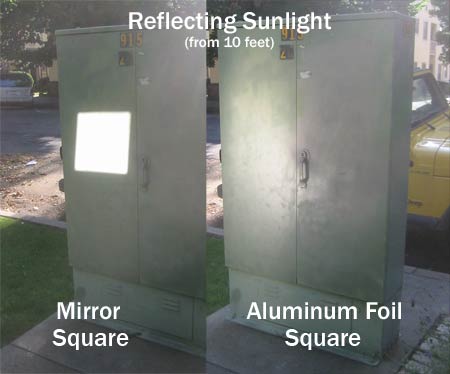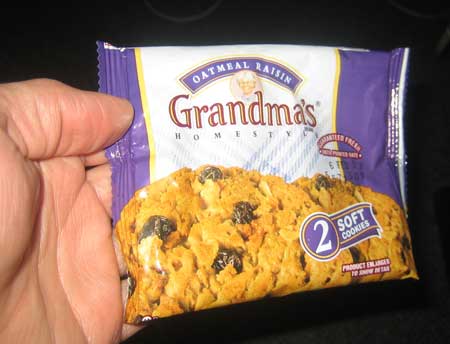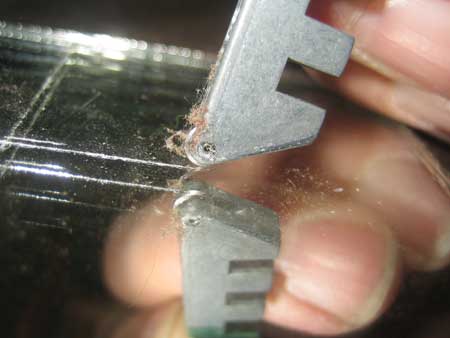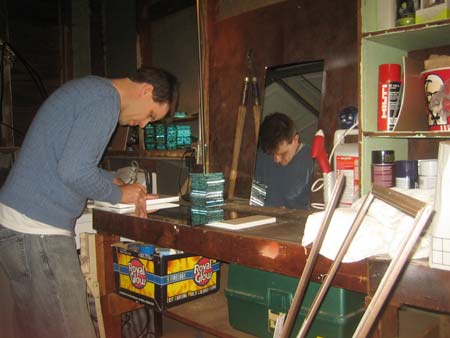

 |
 |
| Intro | Build | Foil | Mirror | Burn | Epilogue | FAQ |
| 1 | 2 3 4 5 6 | 7 8 9 10 | 11 12 13 14 | 23 | FAQ |

Covering the dish in actual mirrors was the ultimate goal, and I had been saving and hording mirrors since my first solar collecting project. However, I didn't yet have enough. I already knew that aluminum foil was a poor substitute for an actual mirror. If my haircut doesn't convince you, take a look at the photo to the right. Aluminum foil probably reflects the same amount of light, but it isn't all going in the same direction. Every mark and wrinkle in the foil blurs the reflected light. |

Another idea came from Grandma. |
|
All sorts of food packages are made with Mylar film. I could save up a few hundred, wipe the trans fat off of the shiny interior and use them to cover my dish. Re-using this trash would be even cheaper than aluminum foil. I doubled my intake of Cool Ranch Doritos, and devised a plan to test their reflectivity against glass mirrors. (Cockeyed readers: Please save your Mylar food packages. Thank you.) |
|
There were several problems with using glass. It would cost the most, and I'd have to cut a lot of little squares. My preliminary estimates were that I would need 113 square feet (10.5 m2) of mirrors. I had several big mirrors, three boxes of mirror tiles, and eight of those cheap long mirrors that fit on a door. It wasn't enough. I decided to use square mirrors, four inches (10cm) on a side. To cover the dish, I would need to cut about 1,000 such mirrors. It was a little daunting, but I was eager to get started. |

Cutting glass is really pretty fun, even after a couple of hundred tiles. My first step was to cut my big mirrors into one-foot squares. This photo illustrates the first step, scoring. I used a small tool with a sharp roller on the end. With some effort, the roller etches a line into the surface of the glass. Ignore the bit of lint in this photo. Once a straight line is etched, only a little effort is required to snap the glass into two pieces, along that line. Snapping glass which is 1/8th-inch thick takes about the same amount of effort as cracking a Popsicle stick in two. |

To speed the process of etching lines, I constructed a J-shaped jig from leftover shelving. My mirror tiles would slide under a four-inch overhang, allowing me to quickly scribe a line with the glass cutter. This would divide a 1-foot tile with tic-tac-toe lines, which I could then snap into 9 equal squares. It was ugly, but it worked really well. I could score scores of scores per hour. Sometimes I think that the only projects worth doing are the ones which require building a new tool. http://video.google.com/videoplay?docid=4986966826686746894&hl=en
|
 It was a big job. The first two stacks of mirrors. |
 I
stayed up for many late nights, drinking Coke, scoring and cutting up
mirrors. I
stayed up for many late nights, drinking Coke, scoring and cutting up
mirrors.
|
|
June, after a moment of reflection, said goodbye to this big mirror. The glass on big mirrors like this one was almost a quarter-inch thick. |

The squares started to stack up. Here are about 280. Every once in a while, a mirror would snap along an unexpected line, reminding me that this could be dangerous. |
 I hadn't planned how to arrange the mirrors on the dish. It looked like I could either use a concentric ring pattern or a square grid. Any pattern would leave some empty space between the mirrors. |
|
45 mirrors. I had a long way to go. |
|
Please continue reading page seven of the Light Sharpener. |
| Intro | Build | Foil | Mirror | Burn | Epilogue | FAQ |
| 1 | 2 3 4 5 6 | 7 8 9 10 | 11 12 13 14 | 23 | FAQ |
Other incredible stuff | Home | Contact Rob | Making fire with two sticks | My first solar parabola | Fire with Coke can and toothpaste
May 31st, 2007. Terms and Conditions Copyright 2007 Cockeyed.com